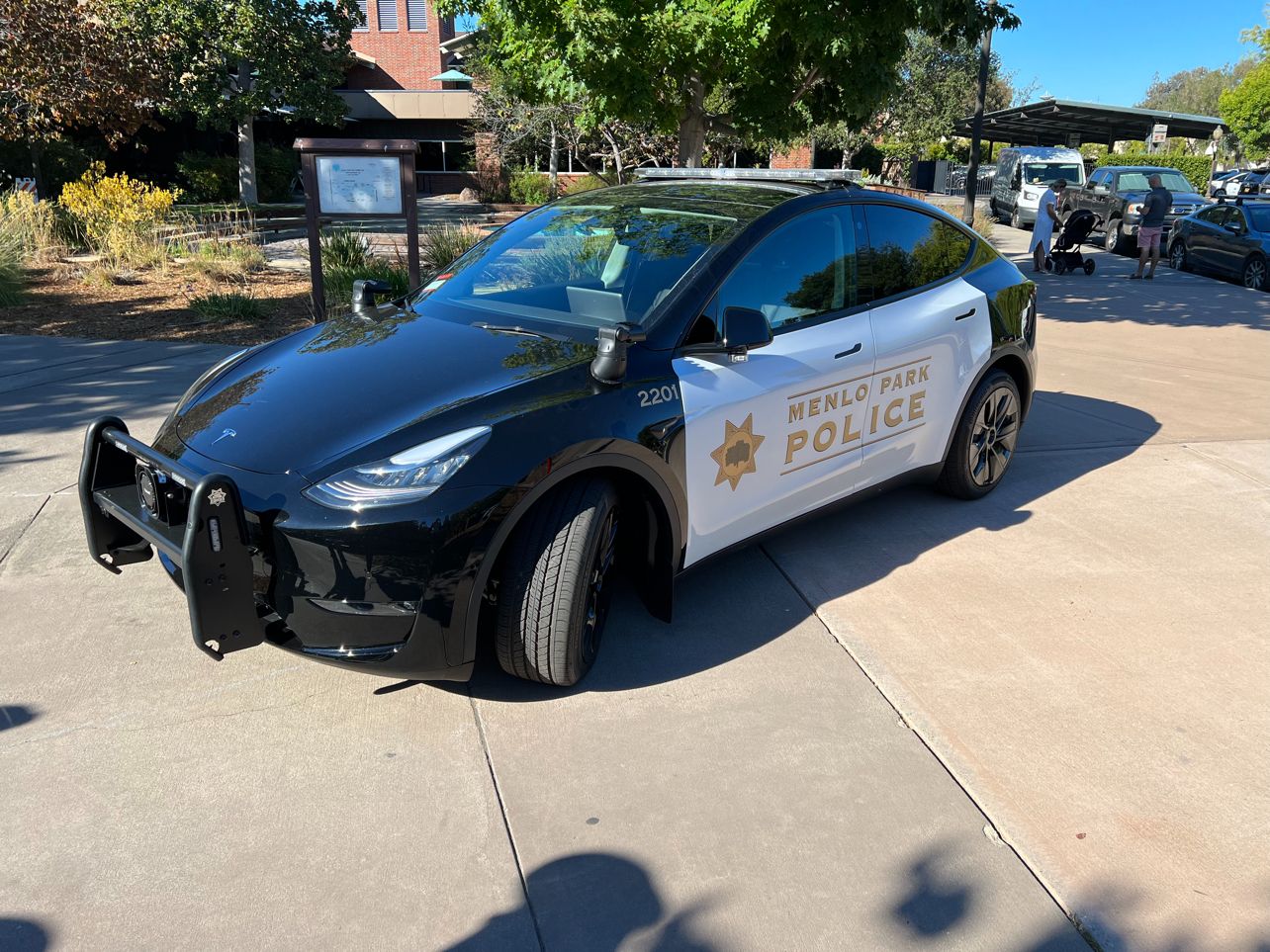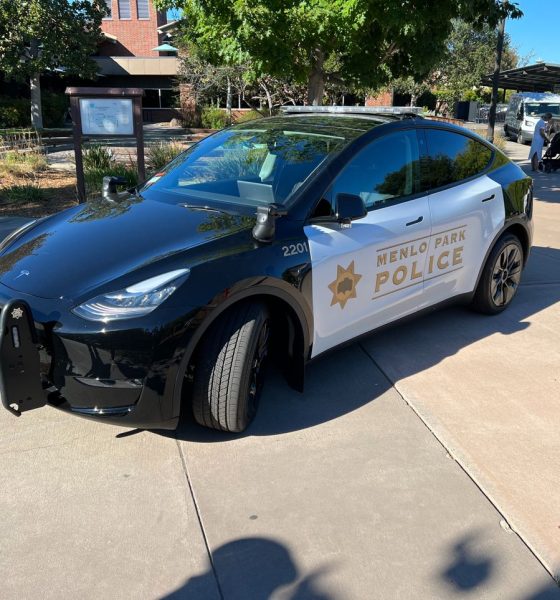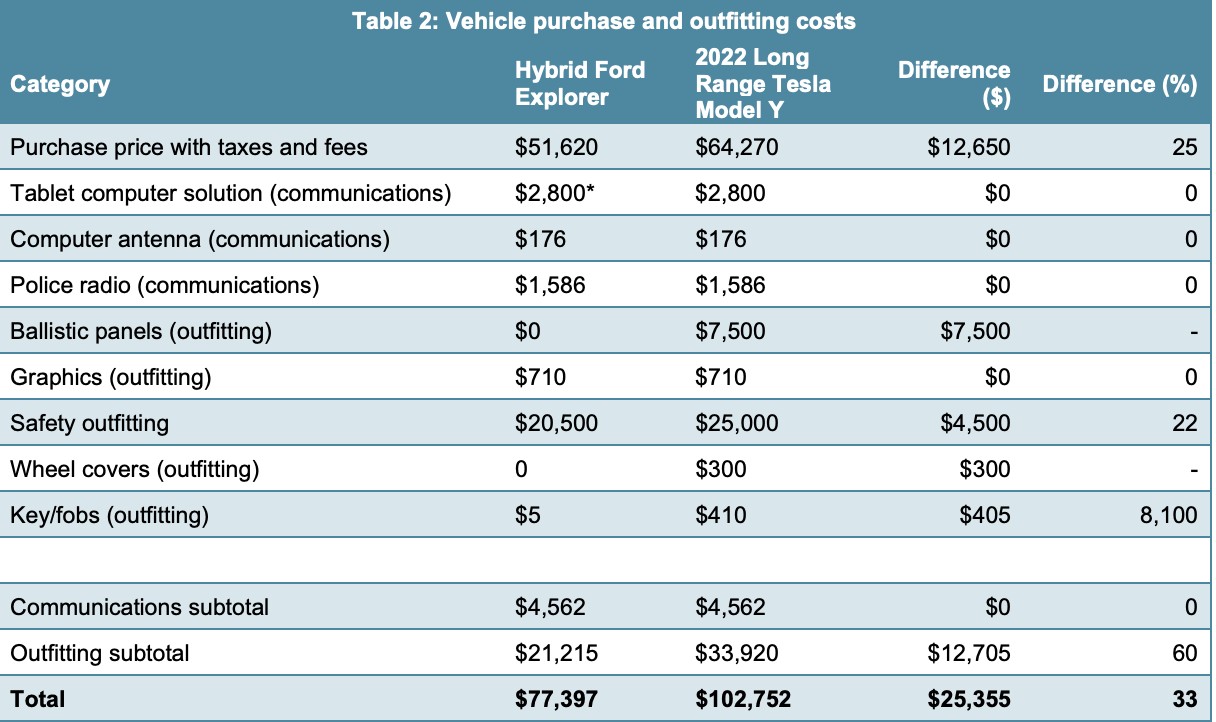

News
Tesla gets its first negative review from a police force standpoint
Tesla vehicles have been adopted by several police forces across the United States, and they have widely been met with positive reviews, mainly driven by cost savings and performance advantages.
However, one department has found the Tesla fleet to be less than ideal, even going as far as saying “(they) do not appear to the be the ‘patrol cars of the future.’”
In 2019, the Menlo Park, California City Council voted 3-2 to adopt a Sustainable Fleet Policy in 2020. The Model Y Long Range was chosen as the vehicle for the Menlo Park Police Department, beating out the Ford Mustang Mach-E and some other EVs.
Three units make up the EV portion of the Menlo Park Police Fleet.
Teslas need to be outfitted and modified for police use. Lights, sirens, seats, specialized seatbelts, communications equipment, a gun rack, window guards, and ballistic door panels are all equipped to make it a full-fledged law enforcement vehicle.
Tesla Model Y showcased at Menlo Park Police employee appreciation event
Outfitting a Tesla Model Y was roughly $12,700 more expensive than a Ford Explorer Hybrid, and the difference when also factoring in the initial cost of the vehicle came to $25,355, a 33 percent increase for the Tesla compared to the Ford.

Other police departments have canceled out the difference in initial cost after just a year of operation.
Officers also said the “small interior space” and “smart car” features, along with the low vehicle profile all made things more difficult.
Space Constraints
In terms of space constraints, after the vehicle is outfitted for patrol use, there is a “reduce amount of space for an officer in full patrol gear.” The report, released by the Menlo Park City Council, said:
“The width of duty belts and bulletproof vests do not fit well in the bucket seat and the height of the center console required larger officers to sit at an angle or with their sidearm pinned and inaccessible while in the vehicle. The equipment overhangs the passenger seat making it nearly unusable. This is not an immediate issue, as the current patrol operations do not deploy two officers in every vehicle, but would limit the ability to transport personnel or change operations in the future. In particular, the passenger seat space would not allow training officers to comfortably sit next to a trainee for a 12-hour shift, preventing field training for new officers. The rear seats provide very little room for anyone detained or transported in the back of the car.”
“Smart Car” Challenges
The Menlo Park PD listed Autopilot interference, lighting controls, and proximity locking, sleep mode, and self-closing doors as disadvantages:
“The following “smart” features of the Teslas created challenges for patrol operations:
-
- Autopilot interference: There is a delay when officers shift into drive; and on occasion the Teslas automatically stop when an officer attempts to pull off to the side of the road to approach vehicles or people.
- Lighting controls (tablet): Tesla does not allow direct access to the system; officers need to use a multistep touch screen process to follow standard practice to dim their lights upon approach at night.
- Proximity locking, sleep mode and self-closing doors: The car knows when the key is, or is not, present within an effective range. The cars will not lock if the key, or enabled smartphone, are near the vehicles and will conversely lock if the key or smartphone is away from the vehicle.”
According to Almanac News, Menlo Park’s local news, the City Council approved the purchase of a Chevrolet Blazer for a future Police vehicle. It appears the Department is just not set on the Tesla for police use.
“I am very proud that we tried the Teslas, and not everything works,” Betty Nash, a Council member, said. “I appreciate all the work that the police department did with working through all the bumps.”
I’d love to hear from you! If you have any comments, concerns, or questions, please email me at joey@teslarati.com. You can also reach me on Twitter @KlenderJoey, or if you have news tips, you can email us at tips@teslarati.com.

Elon Musk
Tesla CEO Elon Musk drops massive bomb about Cybercab
“And there is so much to this car that is not obvious on the surface,” Musk said.

Tesla CEO Elon Musk dropped a massive bomb about the Cybercab, which is the company’s fully autonomous ride-hailing vehicle that will enter production later this year.
The Cybercab was unveiled back in October 2024 at the company’s “We, Robot” event in Los Angeles, and is among the major catalysts for the company’s growth in the coming years. It is expected to push Tesla into a major growth phase, especially as the automaker is transitioning into more of an AI and Robotics company than anything else.
The Cybercab will enable completely autonomous ride-hailing for Tesla, and although its other vehicles will also be capable of this technology, the Cybercab is slightly different. It will have no steering wheel or pedals, and will allow two occupants to travel from Point A to Point B with zero responsibilities within the car.
Tesla shares epic 2025 recap video, confirms start of Cybercab production
Details on the Cybercab are pretty face value at this point: we know Tesla is enabling 1-2 passengers to ride in it at a time, and this strategy was based on statistics that show most ride-hailing trips have no more than two occupants. It will also have in-vehicle entertainment options accessible from the center touchscreen.
It will also have wireless charging capabilities, which were displayed at “We, Robot,” and there could be more features that will be highly beneficial to riders, offering a full-fledged autonomous experience.
Musk dropped a big hint that there is much more to the Cybercab than what we know, as a post on X said that “there is so much to this car that is not obvious on the surface.”
And there is so much to this car that is not obvious on the surface
— Elon Musk (@elonmusk) January 2, 2026
As the Cybercab is expected to enter production later this year, Tesla is surely going to include a handful of things they have not yet revealed to the public.
Musk seems to be indicating that some of the features will make it even more groundbreaking, and the idea is to enable a truly autonomous experience from start to finish for riders. Everything from climate control to emergency systems, and more, should be included with the car.
It seems more likely than not that Tesla will make the Cybercab its smartest vehicle so far, as if its current lineup is not already extremely intelligent, user-friendly, and intuitive.
Investor's Corner
Tesla Q4 delivery numbers are better than they initially look: analyst
The Deepwater Asset Management Managing Partner shared his thoughts in a post on his website.

Longtime Tesla analyst and Deepwater Asset Management Managing Partner Gene Munster has shared his insights on Tesla’s Q4 2025 deliveries. As per the analyst, Tesla’s numbers are actually better than they first appear.
Munster shared his thoughts in a post on his website.
Normalized December Deliveries
Munster noted that Tesla delivered 418k vehicles in the fourth quarter of 2025, slightly below Street expectations of 420k but above the whisper number of 415k. Tesla’s reported 16% year-over-year decline, compared to +7% in September, is largely distorted by the timing of the tax credit expiration, which pulled forward demand.
“Taking a step back, we believe September deliveries pulled forward approximately 55k units that would have otherwise occurred in December or March. For simplicity, we assume the entire pull-forward impacted the December quarter. Under this assumption, September growth would have been down ~5% absent the 55k pull-forward, a Deepwater estimate tied to the credit’s expiration.
“For December deliveries to have declined ~5% year over year would imply total deliveries of roughly 470k. Subtracting the 55k units pulled into September results in an implied December delivery figure of approximately 415k. The reported 418k suggests that, when normalizing for the tax credit timing, quarter-over-quarter growth has been consistently down ~5%. Importantly, this ~5% decline represents an improvement from the ~13% declines seen in both the March and June 2025 quarters.“
Tesla’s United States market share
Munster also estimated that Q4 as a whole might very well show a notable improvement in Tesla’s market share in the United States.
“Over the past couple of years, based on data from Cox Automotive, Tesla has been losing U.S. EV market share, declining to just under 50%. Based on data for October and November, Cox estimates that total U.S. EV sales were down approximately 35%, compared to Tesla’s just reported down 16% for the full quarter. For the first two months of the quarter, Cox reported Tesla market share of roughly a 65% share, up from under 50% in the September quarter.
“While this data excludes December, the quarter as a whole is likely to show a material improvement in Tesla’s U.S. EV market share.“
Elon Musk
Tesla analyst breaks down delivery report: ‘A step in the right direction’
“This will be viewed as better than feared deliveries and a step in the right direction for the Tesla story heading into 2026,” Ives wrote.

Tesla analyst Dan Ives of Wedbush released a new note on Friday morning just after the company released production and delivery figures for Q4 and the full year of 2025, stating that the numbers, while slightly underwhelming, are “better than feared” and as “a step in the right direction.”
Tesla reported production of 434,358 and deliveries of 418,227 for the fourth quarter, while 1,654,667 vehicles were produced and 1,636,129 cars were delivered for the full year.
Tesla releases Q4 and FY 2025 vehicle delivery and production report
Interestingly, the company posted its own consensus figures that were compiled from various firms on its website a few days ago, where expectations were set at 1,640,752 cars for the year. Tesla fell about 4,000 units short of that. One of the areas where Tesla excelled was energy deployments, which totaled 46.7 GWh for the year.
🚨 Wedbush’s Dan Ives has released a new note on Tesla $TSLA:
“Tesla announced its FY4Q25 delivery numbers this morning coming in at 418.2k vehicles slightly below the company’s consensus delivery estimate of 422.9k but much better than the whisper numbers of ~410k as the…
— TESLARATI (@Teslarati) January 2, 2026
In terms of vehicle deliveries, Ives writes that Tesla certainly has some things to work through if it wants to return to growth in that aspect, especially with the loss of the $7,500 tax credit in the U.S. and “continuous headwinds” for the company in Europe.
However, Ives also believes that, given the delivery numbers, which were on par with expectations, Tesla is positioned well for a strong 2026, especially with its AI focus, Robotaxi and Cybercab development, and energy:
“This will be viewed as better than feared deliveries and a step in the right direction for the Tesla story heading into 2026. We look forward to hearing more at the company’s 4Q25 call on January 28th. AI Valuation – The Focus Throughout 2026. We believe Tesla could reach a $2 trillion market cap over the coming year and, in a bull case scenario, $3 trillion by the end of 2026…as full-scale volume production begins with the autonomous and robotics roadmap…The company has started to test the all-important Cybercab in Austin over the past few weeks, which is an incremental step towards launching in 2026 with important volume production of Cybercabs starting in April/May, which remains the golden goose in unlocking TSLA’s AI valuation.”
It’s no secret that for the past several years, Tesla’s vehicle delivery numbers have been the main focus of investors and analysts have looked at them as an indicator of company health to a certain extent. The problem with that narrative in 2025 and 2026 is that Tesla is now focusing more on the deployment of Full Self-Driving, its Optimus project, AI development, and Cybercab.
While vehicle deliveries still hold importance, it is more crucial to note that Tesla’s overall environment as a business relies on much more than just how many cars are purchased. That metric, to a certain extent, is fading in importance in the grand scheme of things, but it will never totally disappear.
Ives and Wedbush maintained their $600 price target and an ‘Outperform’ rating on the stock.








